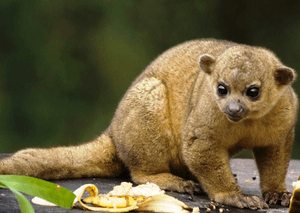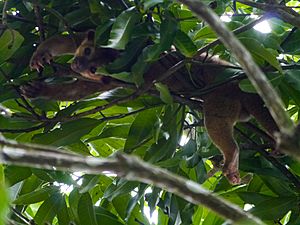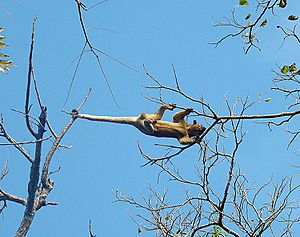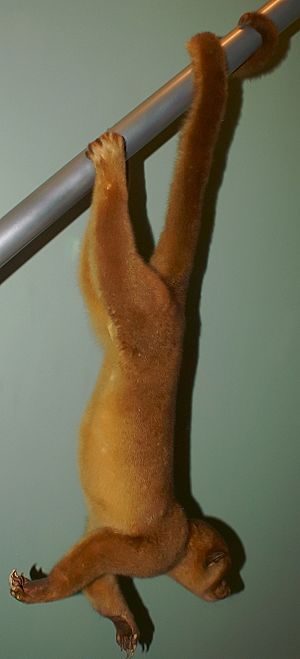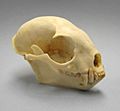Kinkajou facts for kids
Quick facts for kids Kinkajou |
|
|---|---|
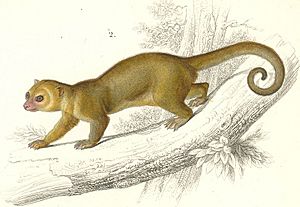 |
|
| Conservation status | |
| Scientific classification | |
| Kingdom: | |
| Class: | |
| Order: | |
| Family: | |
| Genus: |
Potos
Geoffroy Saint-Hilaire & Cuvier, 1795
|
| Species: |
P. flavus
|
| Binomial name | |
| Potos flavus (Schreber, 1774)
|
|
 |
|
| Kinkajou range | |
The kinkajou (Potos flavus) is a tropical rainforest mammal of the family Procyonidae related to olingos, coatis, raccoons, and the ringtail and cacomistle.
It is the only member of the genus Potos and is also known as the "honey bear". Kinkajous are arboreal, a lifestyle they evolved independently; they are not closely related to any other tree-dwelling mammal group (primates.
Native to Central America and South America, this mammal is not an endangered species, though it is seldom seen by people because of its strict nocturnal habits.
However, they are hunted for the pet trade, for their fur (to make wallets and horse saddles) and for their meat. The species has been included in Appendix III of CITES by Honduras, which means that exports from Honduras require an export permit and exports from other countries require a certificate of origin or re-export.
Size and appearance
An adult kinkajou weighs 1.4–4.6 kg (3–10 lb). The adult body length is 40–60 cm (16–24 in); in addition to body length, the length of the prehensile tail is 40–60 cm (16–24 in). The kinkajou's woolly fur consists of an outer coat of gold (or brownish-gray) overlapping a gray undercoat. It has large eyes and small ears. It also has short legs with five toes on each foot and sharp claws.
Range and habitat
Kinkajous evolved in Central America and invaded the formerly isolated continent of South America several million years ago, as part of the Great American Interchange, when formation of the Isthmus of Panama made it possible to do so.
Kinkajous range from east and south of the Sierra Madres in Mexico, throughout Central America to Bolivia east of the Andes and the Atlantic Forest of southeastern Brazil.
They are found in closed-canopy tropical forests, including lowland rainforest, montane forest, dry forest, gallery forest and secondary forest. Deforestation is thus a potential threat to the species.
Diet
Although the kinkajou is classified in the order Carnivora and has sharp teeth, its omnivorous diet consists mainly of fruit, particularly figs. To eat softer fruits they hold it with their forepaws, then scoop out the pulp with their tongue. They may play an important role in seed dispersal. Leaves, flowers, and various herbs make up much of the other 10% of their diet. They sometimes eat insects, particularly ants.
The kinkajou's slender five-inch tongue helps the animal to obtain fruit and to lick nectar from flowers, so that it sometimes acts as a pollinator.
Behavior
Kinkajous spend most of their life in trees, to which they are particularly well adapted. Like raccoons, kinkajous' remarkable abilities rival those of primates. The kinkajou has a short-haired, fully prehensile tail, which it uses as a "fifth hand" in climbing. It does not use its tail for grasping food.
It can rotate its ankles and feet 180°, making it easy for the animal to run backward over tree limbs and climb down trees headfirst. Scent glands near the mouth, on the throat, and on the belly allow kinkajous to mark their territory and their travel routes.
Kinkajous sleep in family units and groom one another. While they are usually solitary when foraging, they occasionally forage in small groups.
A nocturnal animal, the kinkajou's peak activity is usually between about 7:00 PM and midnight, and again an hour before dawn. During daylight hours, kinkajous sleep in tree hollows or in shaded tangles of leaves, avoiding direct sunlight.
Kinkajous breed throughout the year, giving birth to one or occasionally two small babies after a gestation period of 112 to 118 days. They live an average of about 23 years in captivity, with a maximum recorded life span of 41 years.
As pets
Kinkajous are sometimes kept as exotic pets. They are playful, generally quiet, docile, and have little odor. However, they can occasionally be aggressive. Kinkajous dislike sudden movements, noise, and being awake during the day.
An agitated kinkajou may emit a scream and attack, usually clawing its victim and sometimes biting deeply. In 2011, the Centers for Disease Control and Prevention reported that pet kinkajous in the United States can be carriers of the raccoon roundworm Baylisascaris procyonis, which is capable of causing death in humans, if the brain is infected.
Images for kids
See also
 In Spanish: Kinkajú para niños
In Spanish: Kinkajú para niños



